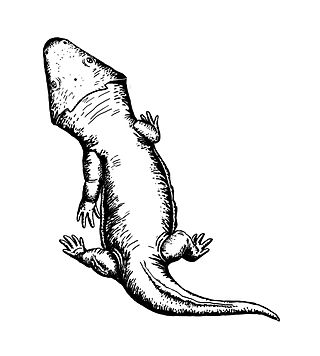
Huntsman spiders, members of the family Sparassidae, catch their prey by hunting rather than in webs. They are also called giant crab spiders because of their size and appearance. Larger species sometimes are referred to as wood spiders, because of their preference for woody places. In southern Africa the genus Palystes are known as rain spiders or lizard-eating spiders. Commonly, they are confused with baboon spiders from the Mygalomorphae infraorder, which are not closely related.

Blepharisma is a genus of unicellular ciliate protists found in fresh and salt water. The group includes about 40 accepted species, and many sub-varieties and strains. While species vary considerably in size and shape, most are easily identified by their red or pinkish color, which is caused by granules of the pigment blepharismin.

Endemism is the state of a species being found only in a single defined geographic location, such as an island, state, nation, country or other defined zone; organisms that are indigenous to a place are not endemic to it if they are also found elsewhere. For example, the Cape sugarbird is found exclusively in southwestern South Africa and is therefore said to be endemic to that particular part of the world. An endemic species can also be referred to as an endemism or, in scientific literature, as an endemite. Similarly, many species found in the Western ghats of India are examples of endemism.

The Drosophilidae are a diverse, cosmopolitan family of flies, which includes species called fruit flies, although they are more accurately referred to as vinegar or pomace flies. Another distantly related family of flies, Tephritidae, are true fruit flies because they are frugivorous, and include apple maggot flies and many pests. The best known species of the Drosophilidae is Drosophila melanogaster, within the genus Drosophila, also called the "fruit fly." Drosophila melanogaster is used extensively for studies concerning genetics, development, physiology, ecology and behaviour. Many fundamental biological mechanisms were discovered first in D. melanogaster. The fruit fly is mostly composed of post-mitotic cells, has a very short lifespan, and shows gradual aging. As in other species, temperature influences the life history of the animal. Several genes have been identified that can be manipulated to extend the lifespan of these insects. Additionally, Drosophila subobscura, also within the genus Drosophila, has been reputed as a model organism for evolutionary-biological studies, along with D. sechellia for the evolution of host specialization on the toxic noni fruit and Scaptomyza flava for the evolution of herbivory and specialist on toxic mustard leaves.

Strombus is a genus of medium to large sea snails, marine gastropod molluscs in the family Strombidae, which comprises the true conchs and their immediate relatives. The genus Strombus was named by Swedish Naturalist Carl Linnaeus in 1758. Around 50 living species were recognized, which vary in size from fairly small to very large. Six species live in the greater Caribbean region, including the queen conch, Strombus gigas, and the West Indian fighting conch, Strombus pugilis. However, since 2006, many species have been assigned to discrete genera. These new genera are, however, not yet found in most textbooks and collector's guides.

Pyramidellidae, common name the pyram family, or pyramid shells, is a voluminous taxonomic family of mostly small and minute ectoparasitic sea snails, marine heterobranch gastropod molluscs. The great majority of species of pyrams are micromolluscs.

Palaeoheterodonta is a subterclass of bivalve molluscs. It contains the extant orders Unionida and Trigoniida. They are distinguished by having the two halves of the shell be of equal size and shape, but by having the hinge teeth be in a single row, rather than separated into two groups, as they are in the clams and cockles.
Hylomyscus is a genus of rodent in the family Muridae endemic to Africa.

The tufted jay, also known as the painted jay and Dickey's jay, is a species of bird in the crow family Corvidae. It is endemic to a small area of the Sierra Madre Occidental of Sinaloa, Durango, and Nayarit in Mexico. A distinctive large jay, it has a prominent dark crest on its head; purplish blue back, wings, and face; a white spot above the eye and on the cheek; white undersides; and a partially white tail. Its typical call is a quick, four note vocalization.

Pseudothelphusidae is a family of freshwater crabs found chiefly in mountain streams in the Neotropics. They are believed to have originated in the Greater Antilles and then crossed to Central America via a Pliocene land bridge. Some species of this family are troglobitic.
The 1965 Major League Baseball draft is the first year in which a draft took place for Major League Baseball. It was held on June 8–9 in New York City.

Deltasaurus is an extinct genus of Carnian temnospondyl amphibian of the family Rhytidosteidae.

Costellariidae sometimes called the "ribbed miters" is a taxonomic family of minute to medium-sized predatory sea snails, marine gastropod mollusks. This family of snails is also sometimes referred to as Vexillum miters. The main family of miter shells however is Mitridae, a closely related group.

Heliothinae is a small, cosmopolitan subfamily of moths in the family Noctuidae, with about 400 described species worldwide. It includes a number of economically significant agricultural pest species, such as Helicoverpa armigera and Helicoverpa zea.

Hastula is a genus of sea snails, marine gastropod mollusks in the family Terebridae, the auger snails.

Agladrillia is a genus of sea snails, marine gastropod mollusks in the family Drilliidae.

Babelomurex is a genus of sea snails, marine gastropod molluscs in the family Muricidae, the murex snails or rock snails.

Eatoniella is a genus of minute sea snails, marine gastropod mollusks in the family Eatoniellidae, the eatoniellids.

Trophoninae is a subfamily of predatory sea snails, marine gastropod mollusks in the family Muricidae, the rock snails and their allies.

















